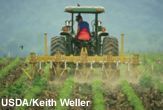Small Farms Sprout in Economic Drought

When the economy gets tough, it seems that the tough get farming. Tens of thousands of small farms were created since 2002, according to new data from the Census of Agriculture.
The farming forecast isn't entirely sunny. But packed with a cornucopia of surprise findings — such as large increases in the number and percentage of Asian, Hispanic, Black and female farmers, and a coup staged by the frigid state of Wisconsin to become the second-leading vegetable producer, behind California — the census brings promising news to those interested in reducing obesity and improving the environment.
What's the connection? More small farms brings greater diversity of crops, more fresh and local foods, less dependency on chemical fertilizers, less concentration of manure, and less emphasis on cheap corn to make unhealthy, industrially produced beef, pork and chicken.
And if Wisconsin can grow vegetables with its yearly average temperature of 43 degrees, nearly every state can become self-sufficient vegetable producers; only seven states are colder.
Back to basics
"I find it hopeful that the number of farms in this country has increased," said newly appointed Secretary of Agriculture Tom Vilsack at the Feb. 4 debut of agricultural census data, held in Washington. "I don't think it is a statistical anomaly that small farms have increased in number... a result of farm programs we have instituted at the USDA to encourage organic farming" and other environmentally benign practices, he said.
Vilsack's comment came nearly a year to the day after the death of Earl Butz, the boisterous Secretary of Agriculture under Nixon and Ford whose mantra "get big or get out" killed the family farm and gave free reign to agribusiness to stuff Americans full of corn, corn syrup and corn-fed animals.
Sign up for the Live Science daily newsletter now
Get the world’s most fascinating discoveries delivered straight to your inbox.
During Butz's reign, farmers began to take on debt by buying more land and expensive machines. The bubble burst in the 1980s with a saturation of corn and soy that couldn't even be unloaded overseas, resulting in massive numbers of farm foreclosures. The number of farms dropped steadily from the 1970s until, the census has revealed, this decade.
Butz resigned in shame in 1976 after making an astonishingly crude racial remark, but his policies have lived on, with corn production (and obesity) still on the rise. Butz was no doubt enthused in recent years to see agribusiness capitalize on fears of oil dependency to push the idea of feeding corn to cars in the form of biofuels.
The farm next door
In Japan, were obesity is negligible and the population lives on average about five years longer than Americans do, most cities and their surroundings are filled with small farms. Farmers south of Tokyo, which has a climate similar to Washington, work year round, planting winter crops such as broccoli and hearty greens, which are then picked and delivered to local stores within a day or two. The system is called chisan, chishou, "produce local, consume local."
Earl would have been knocked on his Butz if he had tried to change the Japanese system. During my visit to Fukuoka in January, I ate tomatoes and strawberries picked the day prior and grown in greenhouses, which were in effect simple plastic tents. Fukuoka's climate is identical to Virginia's.
While the new agricultural census, which covers data collected up through 2007, offers promising results, much work lies ahead. About 5 percent of farmers produce 75 percent of our food, a system dependent on heavy chemical fertilizer and pesticide use and vulnerable to massive food-born-illness outbreaks both natural and intentional.
Worse, most of these new, small farms brought in only a few tens of thousands of dollars. The number of working-class family farms with sales between $100,000 and $250,000 continues to decrease. Mega-farms continue to dominate.
Vilsack called the trend of lost family farms "disturbing" and vowed to improve the situation. Could the new mantra be "family farm values?"
Christopher Wanjek is the author of the books "Bad Medicine" and "Food At Work." His column, Bad Medicine, appears each Tuesday on LiveScience.

Christopher Wanjek is a Live Science contributor and a health and science writer. He is the author of three science books: Spacefarers (2020), Food at Work (2005) and Bad Medicine (2003). His "Food at Work" book and project, concerning workers' health, safety and productivity, was commissioned by the U.N.'s International Labor Organization. For Live Science, Christopher covers public health, nutrition and biology, and he has written extensively for The Washington Post and Sky & Telescope among others, as well as for the NASA Goddard Space Flight Center, where he was a senior writer. Christopher holds a Master of Health degree from Harvard School of Public Health and a degree in journalism from Temple University.
Most Popular




